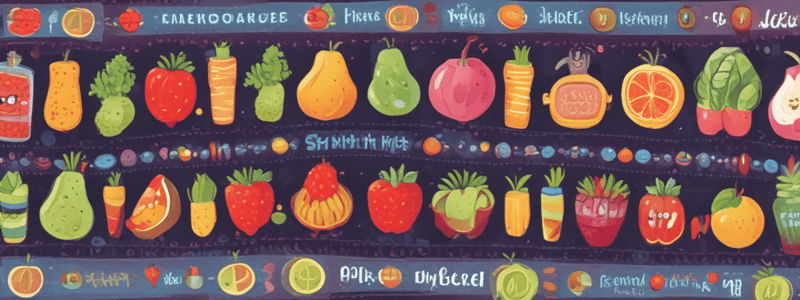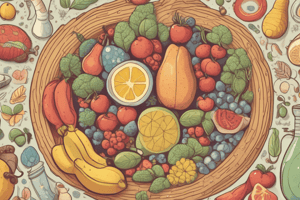Podcast
Questions and Answers
What is the primary purpose of the glycemic index and glycemic load?
What is the primary purpose of the glycemic index and glycemic load?
- To measure the fiber content of foods
- To compare the rise in blood glucose after eating different foods (correct)
- To classify foods based on their protein content
- To determine the calorie count of a serving of food
What is the unit of measurement for the glycemic index?
What is the unit of measurement for the glycemic index?
- Percentage of glucose in the bloodstream
- Grams of carbohydrate
- Units of insulin production
- No unit, it's a relative value (correct)
Why do foods with high fiber contents tend to have a lower glycemic index?
Why do foods with high fiber contents tend to have a lower glycemic index?
- Because they are high in protein
- Because they are digested slowly and do not cause a dramatic increase in blood glucose and insulin levels (correct)
- Because they are low in calories
- Because they are high in fat
What is the difference between the glycemic index and the glycemic load?
What is the difference between the glycemic index and the glycemic load?
Which of the following foods is likely to have a high glycemic index?
Which of the following foods is likely to have a high glycemic index?
Why have diet books recommended avoiding foods with high glycemic indices?
Why have diet books recommended avoiding foods with high glycemic indices?
What is the glycemic load of a food calculated by?
What is the glycemic load of a food calculated by?
What is the significance of 50g of glucose in the context of the glycemic index?
What is the significance of 50g of glucose in the context of the glycemic index?
What is the glycemic index of white bread?
What is the glycemic index of white bread?
Which of the following foods has a low glycemic load?
Which of the following foods has a low glycemic load?
What is the purpose of the glycemic index and glycemic load values?
What is the purpose of the glycemic index and glycemic load values?
Which of the following foods has a high glycemic index?
Which of the following foods has a high glycemic index?
What is a limitation of using glycemic index and glycemic load values for menu planning?
What is a limitation of using glycemic index and glycemic load values for menu planning?
What is associated with high GI/GL diets?
What is associated with high GI/GL diets?
Which of the following is a benefit of a low GI diet?
Which of the following is a benefit of a low GI diet?
What should people with diabetes consider when following a low GI or low GL diet?
What should people with diabetes consider when following a low GI or low GL diet?
Which of the following foods has a moderate glycemic index value?
Which of the following foods has a moderate glycemic index value?
Which food has the lowest glycemic index in the following options?
Which food has the lowest glycemic index in the following options?
Flashcards are hidden until you start studying
Study Notes
What are Glycemic Index and Glycemic Load?
- Glycemic Index (GI) is a way of classifying foods by comparing the rise in blood glucose after eating a portion of a food that supplies 50g of digestible carbohydrate to the rise that occurs after eating a standard source of carbohydrate, such as 50g of glucose.
- Glycemic Load (GL) is the grams of carbohydrate in a serving of food multiplied by the food's GI, then divided by 100.
Characteristics of Foods based on GI and GL
- Foods with high GIs (70 or more) include sucrose, sugary foods, and highly refined starchy foods like cornflakes, baked potatoes, and white rice.
- Foods with low to moderate GIs (less than 70) include raw apples, carrots, spaghetti, fat-free milk, and peanuts.
- GL of a food is usually lower than its GI.
- Foods with low GLs have values below 10, while high GL foods have values of more than 20.
Examples of Foods with their GI and GL Values
- Potato, Russet, baked: GI - 158, GL - 26
- Cornflakes cereal: GI - 130, GL - 24
- Apple, raw: GI - 56, GL - 6
- Fat-free milk: GI - 46, GL - 4
- Peanuts: GI - 19, GL - 1
Criticisms and Limitations of GI and GL
- GI and GL values can vary significantly depending on where the food was grown, its degree of ripeness, or the extent of its processing.
- Individuals often experience different blood glucose levels after eating the same carbohydrate-rich food.
- GI and GL values reflect a single food's effect on blood glucose levels, which may be reduced when eaten as part of a meal with a mixture of macronutrients and fiber.
Importance of GI and GL in Health
- Epidemiological studies suggest an association between high GI/GL diets and serious chronic diseases like obesity, type 2 diabetes, cardiovascular disease, and certain cancers.
- Low GI diets may improve blood lipid levels and reduce the risk of cardiovascular disease, and improve HbA1c levels.
- People with diabetes can follow a low GI or low GL diet while monitoring their total carbohydrate intake to control their blood glucose levels.
Studying That Suits You
Use AI to generate personalized quizzes and flashcards to suit your learning preferences.




